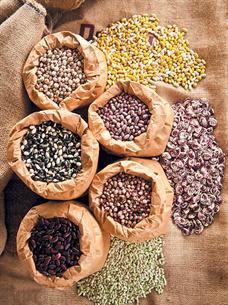Beans are a power food second to none and they ‘beef up’ soups and stews too. Plant in December and you’ll reap the rewards in winter
ALICE SPENSER-HIGGS
Dry beans are a much underrated winter vegetable that adds a particular flavour, texture and substance to slow-cooked comfort food like soups, casseroles and stove-top stews.
“The limit of most people’s bean knowledge is how to make a three-bean salad,” says Sean Freeman of Living Seeds, “and invariably one thinks of the speckled dry beans in the local supermarket.”
There are at least 15 types of heirloom or open-pollinated varieties that are grown specifically for use as dry beans, and
their flavours vary: for example, Christmas lima beans taste like chestnuts; flageolet (French haricot) beans are rich and
creamy; cannellini beans are nutty; and lima beans are buttery. Some crossover beans are also edible, like the Borlotto Fire Tongue bean.
For a winter supply, plant dry bean varieties in December or January, and they will be ready for harvest by the end of autumn.
GROWING TIPS
- Beans are easy to grow, needing full sun and fertile soil.
- Planting depth is three to four times deeper than the length of the bean.
- Water deeply every two days during germination. This prevents the soil from ‘crusting’, which could break the tender necks of the young bean plants.
- Water regularly during the growing season.
HARVESTING
Runner bean varieties need four to five months of growing season; bush beans need three to four months and limas
need a full six to eight months.
Allow the beans to dry out on the plant and pick when thedry pods are crisp.
Store shelled beans in a container in a cool, dry place, or in the freezer as long as they are properly dry. To check if they are dry, hit one of the beans with a hammer. If it shatters, it is dry enough, but if it mashes, it needs to dry out a bit more before freezing me up!
Save some seed for sowing the following year.
HOW TO COOK BEANS
Soak beans for three to four hours, but not longer, to cut down the cooking time. Use three cups of water to one cup of beans.
They swell to three times their size. Start cooking on a rolling boil for about five minutes – this helps to shorten the cooking time. Cut back to a simmer for the remainder of the time. Cook with as little water as possible and try not to add water during the cooking process. However, if you have to top up, use boiling water.
GOOD TO KNOW
Season the beans near the end of the cooking process. Adding salt, tomatoes, lemon or vinegar to the beans during cooking will result in hard beans.
POWER FOOD
Dry beans are a staple food, being a rich source of protein, carbohydrates, vitamins and minerals. Half a cup of cooked dry beans contains about 115 calories and provides 8g of protein. They also contain a number of phytochemicals that are
believed to help prevent osteoporosis, heart disease and some cancers.
VARIETIES TO TRY
Orca or yin-yang beans rate highly on the list of outstanding dry beans. They excel in soups and stews and as baked beans. A quick growing bush bean, it matures in less than four months.
Spanish black beans are used in traditional Spanish or Latin American cooking, often to ‘fill out’ the flavour of vegetarian dishes with a full meaty taste.
French haricot (flageolet) is the aristocrat of beans and is used in authentic French cooking. The mature (but not dry) beans are used as a side dish with lamb and chicken. The fresh mature beans are used as ‘shelly’ beans and can be eaten raw, parboiled or flash-fried. They can also be added to a stir-fry or in the last stages of a soup or stew. Make a tasty dip by blending them with a splash of lemon juice, paprika and salt.
Lima beans are recognised as endangered and South Africa has its own endangered variety in the form of the hereboontjie, which is grown in certain parts of the Cape. The texture of most lima beans is that of a traditional baked potato with a creamy consistency.
Christmas lima beans are especially beautiful and have a superb chestnut flavour. They can also be eaten as shelly beans.
Pakistan maroon beans are used extensively in Pakistani cooking, served both hot and cold, in stews, soups and as a side dish.
Jugo beans or bambarra nuts are traditional African beans that grow underground and can be eaten as a dry or shelly bean, roasted or fried lightly in oil as a snack. The green unripe shells and beans can also be added to soups.
Garbanzo beans (chickpeas) are used in Mediterranean and Eastern cuisine as a side dish or added to main dishes (curries) or turned into hummus or falafels. They have a nutty flavour and buttery texture. The beans can also be used for sprouting.
Cannellini beans are a popular Italian bean with a superior flavour. They can cause ‘gastric distress’ if not boiled for 10 – 15 minutes to break down and remove ‘volatile’ compounds.
Borlotto Fire Tongue is an heirloom bush bean that is traditionally used in Italian soups and stews to provide a rich nutty flavour.
For bean seeds and more information, visit www.livingseeds.co.za; www.organicseeds.co.za and www.soughtafterseedlings.co.za.
SOURCES
DYLAN SWART

